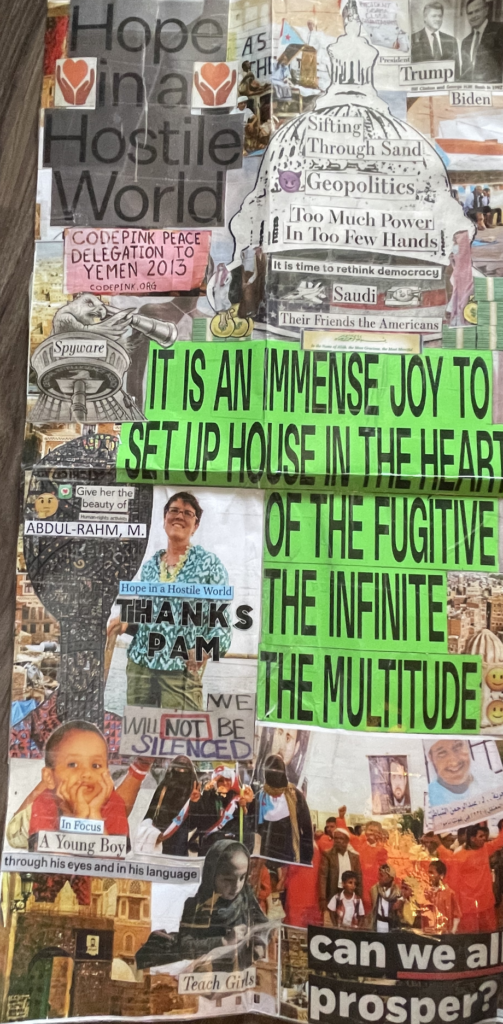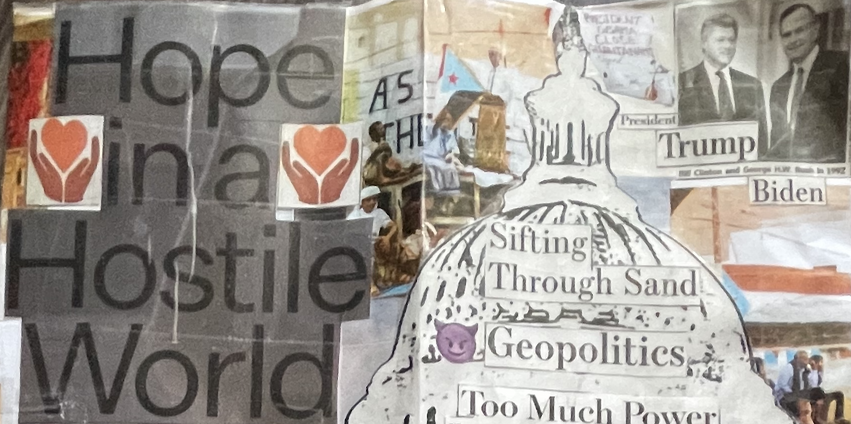A note from the interviewer, MTOC co-founder Pam Bailey: One of the More Than Our Crimes network members has begun gifting me with his very unique style of art, which immediately made physically manifest the wryly humorous and wickedly insightful personality that had begun to emerge from his messages on Corrlinks (the prison email system). His chosen medium is the collage and through it he comments on people and the world. Via Corrlinks, I asked question, after question, after question. Below, I share my conversation with Muhammad Abdul-Rahman.
What role does your art play for you?
Collaging is a creative outlet for sure, but it’s so much more than that; it’s therapeutic. My mother was very artistic as well; our house was full of art –and yes, it was therapeutic for her too. I remember my mother telling me later in life why she had been so skeptical about letting me sleep over at friends’ houses. It was because she had been molested by a friend of the family when she was young, not even 8 years old. That same traumatic experience led to her dating much older men, getting into abusive relationships and, ultimately, heroin addiction.
Your mother was clearly important to who you are as a person. Tell me more about her.
In the early days, we struggled. I can remember, at around the age 8 or 10, boosting [shoplifting] with her at a downtown D.C. department store. Then we sold the stolen merchandise to support her habit and bring home a meal for the family.
But Anita Winston also taught herself and us too, about our history and the world. Books about the Black Panther Party and Malcom X were always in the house once we finally could stay in one place. I also remember her teaching me about the Iran-Contra scandal and the so-called War on Drugs. And, of course, she was sort of an artist extraordinaire. Our house was her own personal art gallery. She took immense pleasure in painting portraits, drawing in pencil, designing clothing, writing poetry, making dolls and jewelry, you name it!
Art was cognitive therapy for her, an alternative to medication. She used it to combat bouts of depression and to cope with the other lingering effects of childhood trauma. Art soothed her and helped still her mind in the midst of a chaotic world. It allowed her to conquer her demons and maintain her sobriety once she finally kicked her addiction.
She also enjoyed tending a garden and practicing the ancient Asian discipline of Tai Chi to strengthen her mindfulness (awareness). She supplemented that with various breathing techniques. My mother was very forward-thinking in this regard; well before employers, sports consultants and life coaches began to understand and honor the importance of meditation and self care to mental health, she was practicing it.
She passed away in 2012, succumbing to her battle with ovarian cancer. She sort of expected it. Even at the peak of good health, she always spoke of death. As Muslim, she considered life on earth a transient state; the soul eventually moves on. So, she taught, it’s important to live life with a purpose!
When my mother died, it felt as if the umbilical cord was truly severed at that moment. For the first time, I was alone in the world. When I was at the D.C. jail, she never missed a permitted visitation. And later, she made the trip to my prison no matter where a “disciplinary transfer” landed me.
The last time I saw her was a few months before her death, while I was housed in the USP in Lee County, Virginia. She looked like a shell of herself, long silky locks shaved, having endured much pain on the van ride up.
When and how did you discover your artistic talents?
I was born prematurely, feet first, with the umbilical cord wrapped around my neck, depriving my brain of oxygen. I was later diagnosed as autistic. But my mom never allowed me to be prescribed medication or placed in special education classes. Anticipating the challenges her baby boy would face in life, she instead cultivated in me this beautiful gift of art to be used as a “magic wand” of sorts. But although I dabbled with drawing, I never really considered myself good at it.
So, if you weren’t actively creating art when you were first incarcerated, what triggered the “re-emergence” of your talent?
I vividly remember the beginning of my collage-making — the ability to convert one man’s discarded trash into a prized treasure.
I was 22 and it was 2004. I had been sent to the “special housing unit” or SHU (solitary confinement) and needed something to do. Art supplies are nonexistent in the SHU. But with a little ingenuity, it’s possible to be creative. I found a discarded, rusty razor lying around — bingo! (In the SHU they pass out disposable razors twice a week. You’re supposed to return them within 30 minutes, intact. But if you’re savvy enough, you can pop the razor out and replace the plastic cover undetected.) I also was lucky enough to find a couple of magazines in my cell left by a prior occupant.
So, using those meager materials, I made my first collage: I pasted on my cell door a cutout of a bare-chested Tupac Shakur (rapper and son of Black Panther member Afeni Shakur), with his head covered by the black hood of an enemy combatant (think 9/11 and Guantanamo). What message do you think my young self was sending to the world with that? Tupac symbolized young Black men and urban street culture in America at the time. He gave incarcerated members of the Black Panthers and Black Liberation Army a mainstream megaphone: full of rage, outspoken and poetic! In a strange turn of fate, it’s like my life was reflecting the art I sought to construct. Having been born Muhammad Abdul-Rahman, arrested in the year 2001, it was like I was channeling Tupac and the black hood of the enemy combatant was now being placed on me. [Tupac is also the stepson of Mutulu Shakur, still incarcerated since his Black Panther days and now 71. He has repeatedly been denied compassionate release despite that fact that the FBOP’s own doctors say his bone marrow cancer is terminal and he has only six months to live.]
With this private art exhibit in my prison within a prison, I guess I was conveying to my peers that we were indeed political prisoners, scapegoated by the U.S. government to fund a war.
And has your political commentary by collaging continued?
Oh yes. But it wasn’t until 2009 — five years later — that my interest in collaging was piqued again. Someone was getting rid of a two-foot stack of old magazines, and I agreed to take them off his hands so I could skim through them for entertainment. But not too long after, my creative juices started flowing!
And as it turned out, I am sort of a natural. This medium greatly appeals to my sense of visual storytelling. From the beginning, all my collages have had a social justice or political theme to them, thanks to my mother.
That same year, one of my collages got me thrown in the SHU for 60 days on trumped-up allegations that I was threatening the president of the United States!
You see, I made a collage showing two figures: One was President Obama, with a pair of angel wings hovering above him and a frown on his face. He was pointing an AK-47 at another version of himself who is sitting on his campaign bus conducting business on a cell phone with devil wings lurking by. The caption read, “Not so fast Mr. President! What about your campaign promises?!”
My intended message was that politicians speak out of both sides of their mouths and will say anything on the campaign trial to get elected. But later, they retreat. Just like President Biden is doing today. No one is satisfied with the symbolic historical firsts enabled when he nominated Vice President Harris and Supreme Court Justice Jackson (both Black women).
But when I tried to mail the collage to my mother, the people in the mail room and then supposedly the FBI thought I was sending a threat to Obama. Prison staff said the Secret Service was going to have to interview me before I got out of the SHU. Fortunately, once I was able to speak to the captain, explain the real meaning and show him another collage I had in my property, he believed me and let me out.
What are your hopes for your art in the future?
Today, I have gifted about six collages to the Free Minds Book Club and Poetry Workshop that are on display at their Dupont Circle (D.C.) headquarters in their makeshift gallery. But I never thought about it being more than a hobby, until I read an interview in The Wall Street Journal with film director Steven Soderbergh. And he talked about the elaborate collages he makes from magazines, just like me.
We’ve witnessed the murder of George Floyd and are living through a racial reckoning, helped along by the spotlight shone on the need for reform by celebrities like Kim Kardashian and Van Jones. I believe that society (including upscale auction houses) are ready to purchase the work of a Black man like myself who has been incarcerated two decades or more and hang it on the walls of their homes!
That’s the world I envision being made possible — one in which the productive acts and dreams of Black men and women are celebrated and supported during their actual lifetimes, not just in the media after we’ve been shot dead by police or our peers.





